Our view at Stack - Simplify growth with an all-in-one platform. Powerful marketing, sales, and support automation. Integrated CMS. Scalable software. Crafted for customer experience.
Effective B2B marketing is challenging to get right. Between creative demands, budget limits, and channel decisions, marketers have a lot to juggle when developing their marketing strategy.
However, the biggest determinant of effective marketing is your audience. That includes whether you understand your audience in the first place and how you communicate with them from there.
The crux?
If you’re not properly targeting your buyer persona, your promotions and advertisements will likely fall flat. In fact, you might as well not be marketing at all.
![→ Download Now: Free Product Marketing Kit [Free Templates]](https://no-cache.hubspot.com/cta/default/53/08b5e1f4-5d26-405b-b986-29c99bd0cb14.png)
Target audiences vary, in general, but where they vary the most is between individual consumers and businesses. Some companies serve individual shoppers, while others cater to companies and organizations.
While similar in some respects, marketing to businesses is not the same as marketing to individual consumers. That’s why an entirely different marketing method — B2B marketing — exists, and that’s why we built this guide.
By the end of this article, you’ll better understand B2B marketing, the most effective B2B marketing strategies, and how you can tap into and convert your business audience.
And if you already know all that? I also share data-backed trends you can expect to see in the B2B space in 2024. For this section, I’ve spoken to some incredible B2B marketers who share their expert insights and tips.
What is B2B?
B2B stands for “business-to-business,” which is a business model where businesses sell products and services to other companies instead of consumers.
If you’re a new marketer in the B2B space or a small B2B business owner learning the ropes, B2B marketing can seem tricky at first.
But don’t worry — you’ll soon learn it’s not so different from typical consumer marketing, and we’ll go over everything you need to know so you can create an effective B2B marketing strategy.
The purpose of B2B marketing is to make other businesses familiar with your brand name, show the value of your product or service, and convert them into customers.
HubSpot is an example of a company that engages in B2B marketing. HubSpot’s customers are other businesses, not individual consumers. Therefore, you can classify all of our marketing efforts as B2B.
B2B vs B2C Marketing
B2B and B2C (business-to-consumer) marketing are very different. B2B and B2C marketing differ in their respective strategies and applications, as well as in their audiences and how they communicate with them.
B2B marketing targets the needs, interests, and challenges of individuals who make purchases on behalf of, or for, their organization (rather than for themselves), thus making the organization the customer.
Here are a few examples of B2B companies:
- A coworking space that leases office spaces to remote teams and freelancers (like Spaces)
- An on-demand order fulfillment, warehousing, and screen printing service (like Printful)
- A marketing software company that sells social media management tools, lead generation software, and other marketing tools to businesses and organizations (like HubSpot!)
B2C marketing targets the needs, interests, and challenges of individual consumers who make purchases on behalf of, or for, themselves, thus making the individual the customer. Here are a few examples of B2C companies:
- An e-commerce company that sells office supplies to remote or self-employed individuals (like Poppin)
- A store that sells t-shirts and other clothing and accessories (like Target)
- A music platform that sells streaming subscriptions (like Spotify)
For more context, let’s take a look at this chart comparing B2B and B2C customers.
|
For B2B marketing |
For B2C marketing |
|
|
Goal |
Customers are focused on ROI, efficiency, and expertise. |
Customers are seeking deals and entertainment (which means marketing needs to be more fun). |
|
Purchase Motivation |
Customers are driven by logic and financial incentives. |
Customers are driven by emotion. |
|
Drivers |
Customers want to be educated (which is where B2B content marketing comes in). |
Customers appreciate education but don’t always need it to make a purchase decision. |
|
Purchase Process |
Customers like (if not prefer) to work with account managers and salespeople. |
Customers like to make purchases directly. |
|
People Involved in Purchase |
Customers often have to confer with decision-makers and other members of their chain of command before making a purchase decision. |
Customers rarely need to confer with others before making a purchase decision. |
|
Purchase Purpose |
Customers make purchases for long-term solutions, resulting in a longer sales cycle, longer contracts, and longer relationships with companies. |
Customers aren’t necessarily looking for long-term solutions or long-term relationships. |
As much as they differ, B2B and B2C companies intersect in many ways. While Poppin sells office supplies to remote or self-employed individuals, they also design corporate office spaces and branded supplies.
On the flip side, Printful offers order fulfillment and warehousing to businesses. They also fill e-commerce printing orders for individuals.
Also, as distinct as the B2B and B2C marketing audiences can be, B2B marketers can always learn from B2C campaigns, too.
I can tell you from experience that there are nuances to consider. For example, logic and financial incentives may drive B2B purchase motivation.
However, anyone who understands sales — whether for B2B or B2C — knows there are typically at least some emotions at play behind any purchase.
In B2B, that could be fear (i.e., are we falling behind our competitors?) or frustration (i.e., our current systems and processes are slowing us down.)
It could also be a feeling of hope (i.e., if we invest in this new software, we can become more efficient and stay ahead of our competitors.)
B2B Marketing Strategies
As I said above, marketing depends on its audience. While B2B and B2C marketing vary, not every piece of B2B marketing material is alike, either.
In this section, I’ll cover various B2B marketing strategies you can implement to reach your specific business audience.
Some of these strategies are preparatory, such as identifying your audience, while others are ready to be executed, such as creating a B2B website.
Let’s get started.
1. Understand the B2B buyer’s journey.
Before we dive into actual strategies you can implement, you need to understand the B2B buyer’s journey.
This information will help you create and implement marketing strategies that meet prospects at every stage of their purchase process.
Because of the higher price point of B2B products, B2B sales cycles tend to be a lot longer than B2C cycles.
Nurturing these prospects via marketing takes a similarly long time, too. That means you must use specific tactics at every stage to drive them toward a purchase decision or a demo request.
In other words: B2B marketing is not as easy as setting up ads on Instagram and hoping for clicks. (We wish! That can work, however, in conjunction with other strategies.)
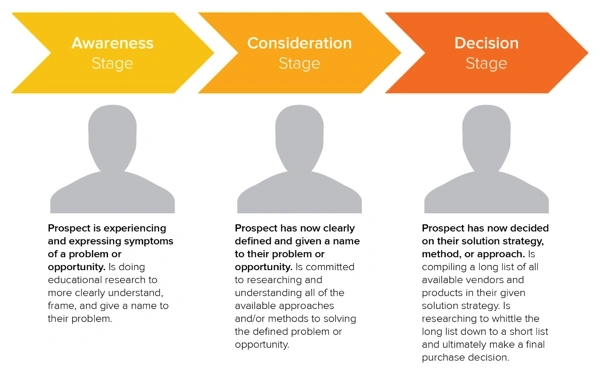
The B2B buyer’s journey is divided into three stages:
- Awareness Stage. The prospect has become aware of a problem and begins educating themselves.
- Consideration Stage. The prospect researches solutions for their new problem.
- Decision Stage. The prospect is ready to make a purchase or formally begin a buying process.
After understanding the buyer’s journey, take this opportunity to create a customer journey map for your company — or, if you’re a new marketer at a B2B company, ask for one for reference.
A customer journey map is a customized version of the buyer’s journey that shows how your brand interacts with prospects during each phase.
With that information, you can understand which marketing strategies, such as content marketing, will be most effective at each stage.
2. Identify your target market and target audience.
Now that you have a strong understanding of the buyer’s journey, it’s time to begin understanding who you’re marketing to specifically.
Who is taking the buyer’s journey and purchasing your products? You get to decide. But it all begins by identifying who they are.
First up, define your target market. For B2B companies, I recommend first identifying your target companies with firmographic data such as:
- Company size, i.e., small, medium, or enterprise.
- Company region or location, i.e., North America, South America, Africa, or specific countries and regions.
- Company industry, i.e., healthcare, fintech, or SaaS.
- Number of employees.
- Revenue.
Then, define your target audience — that is, the specific human prospect who is looking for your brand’s products or services. Remember, you’re not marketing to other companies. You’re marketing to people who work at that company.
You can use demographic and psychographic data to identify individual prospects you’ll be marketing to. This may include their:
- Age.
- Location.
- Gender.
- Education level.
- Job title.
- Behaviors.
- Habits.
- Beliefs.
This information will help you create buyer personas and customer profiles, which in turn will help you understand how they make purchase decisions and which marketing channels they’re more likely to use.
For instance, if you’re targeting an entry-level employee, ages 22-26, at a small business in North America, you can likely use social media to reach them effectively.
Pro Tips
One thing I will say here is that the above should be a starting point.
It’s a wonderful starting point, don’t get me wrong! But to really understand your target audience — rather than making educated guesses — you need to speak directly to them.
So, where possible, I’d always recommend interviewing existing customers or collaborating with sales, customer service, or customer success teams (basically any colleague who speaks to customers directly).
That way, you can get accurate insights about motivations and pain points. (At a minimum, you can glean some of this from existing testimonials or reviews.)
I would also see your buyer personas and customer profiles as unfinished, flexible documentation. That means when you discover something noteworthy, you can update the documents to reflect your findings.
3. Choose your marketing mix (or the 4 Ps of marketing).
Now that you’re armed with your buyer’s firmographic, demographic, and psychographic information, it’s time to start building a B2B marketing strategy tailored specifically to them.
Start by defining your marketing mix, or the 4 Ps of marketing:
- Product — what product you sell.
- Price — how much the product costs.
- Place — where the product is sold.
- Promotion — where customers will find out about the product.
Defining your 4 Ps will help you create a more extensive marketing strategy. It marries all of the information you’ve recently found about your potential customers with the information you already know about your own product.
That will empower you to create a more effective strategy than if you jumped right into tactics and execution.
Featured Resource: Marketing Mix Templates
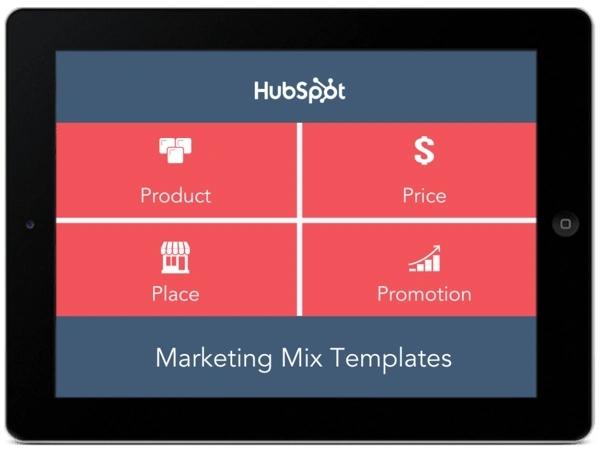
Click here to download the templates for free.
4. Create a B2B marketing plan and a marketing strategy.
Once you’ve defined your marketing mix, you can dive in even more deeply by creating a marketing plan and a marketing strategy.
A marketing strategy marries market conditions with your company’s goals, and a marketing plan provides an actionable roadmap with specific channels and metrics.
What’s most important is outlining your own company’s summary and target markets, then deciding where you’ll promote your company.
Here’s the thing: It’s all too easy to choose specific strategies, like social media marketing and content marketing, without a strategic approach. That can easily lead to overspending in the wrong areas.
To create a marketing plan and strategy, we recommend starting with a template.
But, as with your buyer personas and customer profiles, you should see your marketing plan and strategy as something that can change.
That means when you get more data, and it makes sense to do so, you can pivot your marketing plan and strategy.
Featured Resource: Free Marketing Plan Template
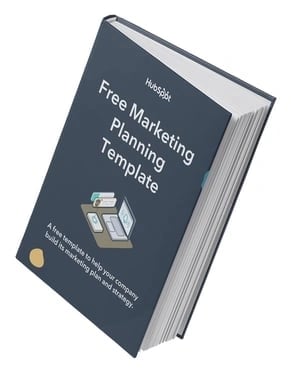
Click here to download HubSpot’s free Marketing Plan Template.
By using this template, you can compile all the information you need to choose the right B2B marketing channels for your company.
You’ll be able to lay out your:
- Business summary and initiatives.
- Target market.
- Market strategy.
- Budget.
- Marketing channels.
- Marketing technology.
In this list, we could have easily shared specific marketing tasks you can do, such as creating online content or publishing short videos.
And while these things will likely be a worthy use of your time, it’s more important to spend your time strategizing to minimize marketing costs and increase your ROI.
Strategizing is the core of your B2B marketing strategy — not implementing specific tactics such as blogging or SEO. Those will come later once you have defined the big picture.
5. Cover all of your B2B marketing bases, such as launching a website.
It’s time to dive into the more tactical aspects of your B2B marketing strategy.
That means covering all of your marketing bases. But we don’t want to dive too deeply yet; this is about nailing down the basics.
The “basics” will vary per industry. For instance, in a more traditional vertical, you might rely less on your website and more on industry events.
That said, you want to make your B2B company has covered most of the following things (click on each one for a checklist to run through):
- Launching a website.
- Creating and maintaining your social media profiles.
- Starting an email marketing newsletter.
- Signing up for industry events and conferences.
No matter which B2B industry you’re in, and regardless of your audience type and age, these things will likely benefit you.
Later, we’ll cover specific types of B2B marketing that you can integrate under each of these strategies. But here’s a good introduction:
- Strategies for your website — content marketing, blogging, SEO.
- Strategies for your social media profiles — social media marketing, paid social media, short-form video marketing.
- Strategies for your email marketing newsletter — email marketing, lead nurturing.
- Strategies for industry events and conferences — event marketing, trade show marketing.
Pro Tips
I’ve outlined “B2B marketing bases” above, and as I said, it’s worth implementing each as a starting point. That said, you don’t have to — and arguably shouldn’t if you don’t have the resources/infrastructure — implement them all at once.
Instead, a staggered approach can help you avoid doing everything yet achieving nothing because you’re under-resourced and overwhelmed.
It can also help you set up each marketing area as a pillar that supports, rather than hinders, the next.
In practice, this might look like launching your website first. That means you can get a steady stream of blog content in the hopper, and your blog content ops running like a well-oiled machine.
Then, you might introduce social media and focus on sharing a mix of new content and repurposing your existing blog content.
This is exactly what I did as a B2B marketing army of one. (Of course, if you have the resources and infrastructure to start everything at once, that’s a different story.)
It’s also worth noting that if you get up and running with one of these areas, stick at it for an extended period and use best practices while also experimenting.
But it still doesn’t prove fruitful. You don’t have to keep going just because you think you should.
If you don’t have an in-house specialist and you have the budget, it might be worth bringing in outside expertise. Even an hour consultation with a specialist might help you pinpoint how you can improve your approach.
You might also be better served reallocating your budget and resources to what’s working for you rather than what isn’t.
6. Run a competitive analysis.
To choose your specific marketing strategies even more strategically, conduct a competitive analysis.
Scope out the market and see which businesses are marketing to your target audience. Learn what they’re currently doing — do they have a website? A presence on a specific social media platform, such as LinkedIn?
Things to be on the lookout for when inspecting competitors are:
- Competitor product offerings.
- Competitor sales tactics and results.
- Competitor marketing content and social media presence.
Featured Resource: 10 Competitive Analysis Templates
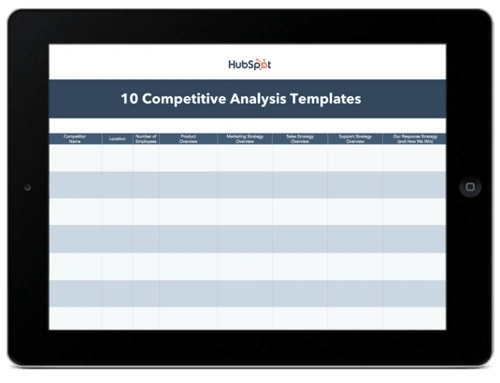
Download Now
Getting a general overview of these items can help you recognize your competitors’ strengths, weaknesses, opportunities, and threats — otherwise known as a SWOT analysis.
Once you understand where they stand, you can better compete with them and choose the best channels.
If none of your competitors are on Instagram, for instance, then Instagram marketing may not be a good strategy to pursue (or, at least, you should test it out first before investing too many resources in it).
Another thing you should be looking out for is what you can do better than your competitors. Consider how you can stand out, which leads us nicely to brand positioning.
7. Determine your brand positioning.
Next, define your brand positioning in the market.
This statement is the who, when, why, and how of your brand identity — or how your brand is perceived through the eyes of the customer.
This will help you cultivate a consistent brand image, regardless of the marketing channels and tactics you use.
Devise a brand positioning statement that your team and prospective customers can believe in, and you’ll be ready for the next step.
Featured Resource: Positioning Statement Templates
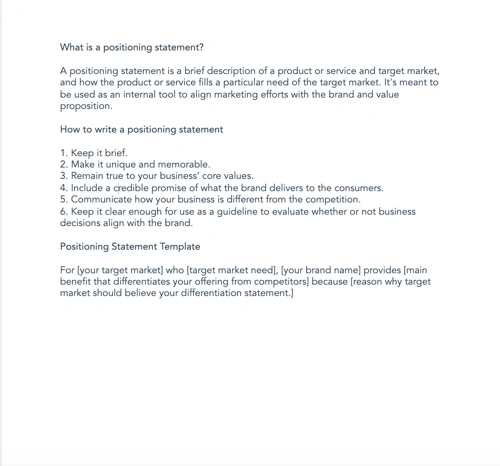
Download for Free Now
8. Explore marketing channels to use.
By now, you’ve likely run across the different types of marketing channels your competitors use successfully and the channels they haven’t taken advantage of.
You’ve also likely gotten an idea of what you want to do based on your big-picture strategizing so far.
With the previous steps completed, you’re ready to diversify your B2B marketing portfolio and reach the businesses you need to.
Depending on your customer segments and competitor analysis, you can explore channels, strategies, and tools to optimize your leads and customer funnels.
Next up, let’s look at the types of B2B marketing you can implement now that you’ve created your overall strategy.
Types of B2B Marketing
The following categories are B2B marketing channels that can connect you to your target audience.
B2B Email Marketing
Email marketing is a tried and true method of reaching both individual consumers and business customers. Most B2B marketers use email — are you one of them?
You should be. Emails lead to engagement, which turns subscribers into leads and then customers.
Download our guide to optimizing email marketing for conversions and learn how to grow your email list, ensure deliverability, and increase engagement.
Unlike B2C customers who respond best to emotions and entertainment, B2B customers look for logic and positive ROI. Essentially, they’re asking themselves, How can your business help my business grow?
Because of this, your email marketing must consistently resonate with your business customers and focus on things that matter to them — like time, money, and resources.
(BUT, that doesn’t mean you shouldn’t also — tactfully, might I add — dig into the emotions that might drive their purchasing decisions.)
Email marketing is also a powerful vehicle for sharing your brand’s content.
Many B2B companies use email newsletters as part of their content marketing program, and the B2B marketers we’ve spoken to say these newsletters are most critical to their content marketing success.
With the constant barrage of emails flooding our inboxes today, it’s more important than ever to create and send out effective marketing emails.
To help you create emails that stand out, you can use HubSpot’s AI Email Writer.
B2B Email Marketing Best Practices
- Write enticing subject lines. Think about your email subject lines as a Netflix trailer — if you can’t hook your audience with a two-minute clip (or, in this case, a few dozen characters), don’t expect them to open and watch (or read) the whole thing. We recommend spending almost as much time on your email subject lines as you do on the emails themselves. You can also run an A/B test on your subject lines to see what works best for your audience.
- Stick to one call-to-action (CTA) per email. If you think the number of emails you receive is a lot, take a look at the CTAs in those emails. Some are packed with two, three, and sometimes up to 10 different CTAs. Don’t make this mistake, which can leave your recipients’ heads spinning, asking, “What should I click on first?” and ultimately clicking on nothing. With one CTA per email, you allow your audience to focus on your email content and, ultimately, one action. A welcome reprieve from today’s frequent decision-making and analysis paralysis.
- Segment your email to reach the most relevant audience. Not every email you send will be appropriate for everyone on your list. Your subscribers may be at different stages of the buyer’s journey or be seeking different solutions. That’s where email list segmentation comes into play. Not only does this help you relate to your audience better, but it also gives your emails that personal feel that says, “Hey, I’m listening, and I know what you’d like to see.” Consumers prefer email quality over quantity anytime.
- Make sure your email designs are responsive. Most email users access their inboxes on their phones, and emails that don’t show up correctly on mobile devices are often deleted. Ouch. Don’t let your email be one of those.
- Don’t be afraid of the cold email. As uncomfortable as it is, the right email can convert new customers — like these cold sales email templates, which will help you get your leads’ attention.
👉🏼 HubSpot Tip: You can’t send marketing emails without any recipients — these people make up your lists. There are plenty of easy ways to grow your email list. Begin with opt-in forms on your website homepage, About page, and blog. Check out HubSpot’s Free Form Builder tool to get started.
B2B Digital Marketing
Every business, whether B2B or B2C, should have a digital presence — which consists of paid ads, search engine optimization, a website, and any other place your B2B company is active online.
Let’s explore several tactics that can strengthen your B2B digital marketing strategy.
1. Define your target audience.
A strong B2B digital marketing strategy starts with defining your target audience or buyer persona. This demographic and psychographic information will inform almost every other marketing activity thereafter.
In short, it makes sure your content and digital material are absorbed by the right eyes and ears (and that no resources go to waste on your end).
2. Create your website.
Secondly, digital marketing can’t function without an informative, engaging website. Most buyers visit a website before making a purchase.
Moreover, the typical B2B sales cycle often involves many key players (such as gatekeepers, decision-makers, and other folks who have to buy into a purchase).
That’s why websites are easy, straightforward ways for influencers to share information about your product or service.
For inspiration on how the best B2B websites are built to impress, check out this video:
3. Optimize your digital presence.
Your website needs to be more than informative and engaging, though it must be discoverable.
You can do this with on-page SEO and technical SEO tactics. These include everything from image alt-text and meta descriptions (what your visitors can see) to structured data and site speed (what your visitors can’t see).
Off-page SEO is also at play here, which refers to external linking strategies and social sharing — SEO tactics that take place off your website.
4. Run PPC campaigns.
Finally, round out your digital presence with pay-per-click (PPC) advertising, which allows you to get your content and brand in front of new audiences via search engines and other advertising platforms.
I recommend maximizing your PPC investment by advertising more than your specific products or services — such as your brand personality, blog or social media content, or company tagline.
The best way to see an ROI from your paid ads is by 1) incorporating your buyer persona data and 2) boosting content that they can relate to.
For example, it’s highly unlikely a brand-new consumer who’s never heard of you is searching for your exact product.
They may be searching for a location-based solution or product feature. To reach the greatest number of potential customers, pay to target relevant categories within your brand vs. promoting your product or services.
B2B Content Marketing
We’ve talked about how B2B customers are focused on expertise, driven by logic, and desire to be educated. What better marketing tool to satisfy these priorities than B2B content marketing?
Whereas a traditional PR marketing strategy interrupts a consumer’s day-to-day with promotional material, a content marketing strategy adds valuable information and informs the consumer — which is precisely what B2B customers are looking for.
Not to mention that content marketing supports SEO efforts, which involves anticipating what your audience is searching for, helping them discover your website and content … and potentially converting them to customers.
It‘s important to note that content marketing is most effective when you align your content to various stages of the buyer’s journey. As Jonathan Franchell, CEO and Founder of Ironpaper, says, “Effective content in the awareness phase educates the buyer on their pain points.”
A frequent mistake B2B organizations make is educating the buyer on their own company, product, or service, Franchell notes. However, he says the buyer isn’t ready for that. They are just beginning to understand their problem.
Franchell adds, “Additionally, B2B companies should test content. Run a test on an incentive and vary the type of content – use a webinar, an ebook, or a video. Understand what format of content attracts the right types of buyers and measure it down to an individual human level.”
Business decision-makers prefer to get information from an article than an ad. Knowing this, I’d say you should be putting the same (if not more) resources into your content marketing than your traditional advertising strategy.
Because the B2B buyer’s journey is slightly different than the B2C buyer’s journey (which has shorter sales cycles and fewer decision-makers involved), the content you create for your B2B content marketing strategy may vary more than the content you’ve seen as a consumer yourself, as illustrated in the below graphic.
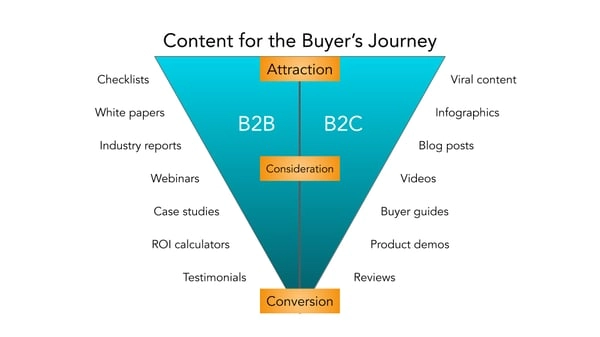
Before you start creating content, though, I recommend creating a business blog.
(Don’t worry; growing your blog readership is easier than you think.)
Your blog will house all the content you create and serve as a home base for readers to visit and subscribe to.
B2B Social Media Marketing
Believe it or not, B2B buyers and C-suite executives can and do use social media when making a purchase. That’s right — social media marketing isn’t just for brands targeting individual consumers.
Many B2B companies struggle with social media marketing, though.
It can be harder to use social media to connect with business customers, especially because (as we mentioned above) there’s typically a lengthier sales cycle and longer chain of command.
Honestly, B2B social media marketing might not be where you convert the greatest number of leads, and that’s OK. It likely comes into play near the beginning of your buyer’s journey.
Social media is a powerful tool for building brand awareness, giving your company an online personality, and humanizing your business — all very powerful factors when it comes to marketing and connecting with potential customers.
Like email marketing, social media is also a highly effective channel for sharing your content and enhancing your brand expertise, the latter of which we know B2B customers appreciate.
Overwhelmed by social media? Spend more time connecting with your followers with our time-saving suite of social tools.
While your social media accounts might not convert as frequently as your content or email marketing, they’re just as important. In this case, followers are just as valuable — you never know when they might convert to leads or customers.
👉🏼 HubSpot Tip: Content shared by employee advocates can generate more engagement than content shared by brands. So, involve your employees in your B2B social media marketing strategy. Encourage them to create their own social media channels and share about life at your company.
Create a culture account (like our @HubSpotLife Instagram) to show what’s going on at work, not just what you’re selling. You never know — this might attract strong talent, too.
B2B Marketing Trends to Watch in 2024 [New Data]
HubSpot’s Blog team conducted research to determine the challenges, opportunities, and initiatives that most B2B marketers are focusing on in 2024.
I pair these findings with insights from B2B marketing experts.
1. Data privacy is the top challenge for marketers.
Top of mind for everyone this coming year is data privacy changes. In fact, 84% of marketers surveyed in our 2024 Industry Trends Report said this had already impacted their 2023 strategy.
As for 2024, marketers expect the following key changes to affect them most:
- Google Chrome’s third-party cookie phaseout (a concern of 47% of marketers).
- Apple iOS Privacy Protection features (41%).
- GDPR (General Data Protection Regulation) (40%).
When it comes to B2B marketers specifically, 21% cite increased data privacy regulations that reduce access to personal data as the biggest challenge they face in 2024.
Second at 20%, is a lack of information on the pain points and challenges their customers face.
Expert Insights: Adopt audience-first thinking.
“As marketers lose the ability to track users as closely, there has to be a necessary move towards audience-first thinking. Instead of ‘following’ users around the internet with advertising, it is instead about being where they are, in an authentic way,” says Marcus Clarke, founder at Searchant.
Clarke explains that this requires marketers to think more deeply about two things:
- Where are your users.
- What content are they consuming across the funnel.
For example, are they consuming before or after photos on Pinterest, or are they watching tutorials on YouTube? Either way, Marcus emphasizes that “it’s about building a better ecosystem to capture demand holistically.”
2. B2B marketers should use AI, but…
At least 70% of US B2B marketers surveyed in HubSpot’s 2024 State of AI survey agree marketers should use generative AI in their roles, but they shouldn’t become overly reliant on it.
That’s compared to 19% who say marketers should leverage generative AI as much as possible, and 11% who think marketers should avoid using generative AI in their roles completely.
Further, over 70% of B2B marketers agree that Generative AI can…
- Improve the quality of the marketing content they create (76%)
- Help them create marketing content more efficiently (76%)
- Help them make significantly more content than they would be able to without it (72%)
… suggesting that the top use cases for AI in B2B marketing specifically are helping with content creation quality, efficiency, and volume. But how can B2B marketers use AI as a wrench, rather than the entire toolkit?
Expert Insights: Treat AI as a tool, not the whole toolkit.
“A lot of our B2B is cold outreach, SEO, emails, and a few demand gen programs. So, it’s mostly content that we use AI for. Then a smattering of use cases in ClickUp automation,” says Adi Abdurab, senior content marketing manager at KodeKloud.
Abdurab notes that in an ideal world, we‘d tell AI to write everything we need, and we’d be done in 23 seconds. “However, at the first opportunity, AI will write something that is not only unreadable but also borderline offensive,” he says.
Adi explains that to counteract this, the team built a custom GPT and have trained it on all of KodeKloud’s (and some of its competitor‘s) marketing collateral. The team uses the GPT to help with brainstorming and outlining. But there’s no instance where they can just send the content without a second glance.
Adi adds, “The biggest thing I continuously catch is that ChatGPT resets itself in a few prompts. And keeps turning copy into a marketing pitch. An impersonal one at that. So, if we have a sales campaign coming out, we’ll ask it to generate ad copy, offers, and filler content. The kind of stuff we know people will skim anyway.”
Another use case from the KodeKloud team is using AI to help with client onboarding. The team uses AI to sift through simple data for them so they can “focus on the key talking points and not get bogged down in needless charts.”
3. Finding new ideas for content is a top challenge B2B marketers face in 2024.
At least 16% of B2B marketers marked “finding ideas for new content” as a top challenge they believe they’ll face in 2024.
It’s no wonder that brainstorming new ideas or angles is the top marketing use case for generative AI, according to recent HubSpot research.
Aside from new ideas, B2B marketers expect to face further challenges when it comes to content marketing.
“Creating content that receives high levels of online engagement” and “Reaching your target audience” came second at 15%. Meanwhile, “Measuring ROI” and “Creating content that attracts more traffic to your website” both came third place at 14%.
Expert Insights: Embrace Technical Content Marketing
“With SEO becoming more saturated and with Google‘s Search Generative Experience (SGE) in beta now and around the corner for the rest of us, it’s time for some new strategies. One that I’m embracing is investing in technical content marketing,” says Lauren Lang, director of content at Uplevel.
Lang explains that decision-makers and stakeholders need more in-depth BOFU pieces to evaluate the product and explore features.
To top it off, you can also use these BOFU pieces to create a moat (helping you differentiate from competitors and stay, well, competitive) by highlighting:
- What truly differentiates your product.
- Why it’s the best way to achieve outcomes.
- How it works for common use cases.
Lang adds, “This goes a layer deeper than typical SEO content, but decision-makers are looking for this type of information. The more that you can present it to them in an accessible way (rather than making them weed through your product documentation), the more likely your product will stand out.”
Getting started: Technical content marketing is worth exploring if you’re looking for new B2B content ideas. To get started, Lauren recommends reaching out to a product marketer on your team if you have one. But if not, reach out to your product team directly and start collaborating.
4. Short-form video content leads in ROI for B2B marketers.
HubSpot’s 2024 Trends Report found that at 17%, short-form video content (i.e., TikTok, Reels, YouTube Shorts, etc) provided marketers the most ROI.
For context, this was followed by creating content that reflected their brand’s values (e.g., social responsibility) at 13%.
It’s no wonder, then, that out of the B2B marketers surveyed, 53% plan on increasing their investment for short-form video in 2024, while 36% plan to continue to invest the same amount.
But how does short-form video work in B2B specifically?
Expert Insights: Foster a recognizable, relatable brand.
Daniel Kosmala, senior marketing manager at Uscreen, notes that short-form content for B2B companies is very difficult. The sales process is typically longer than you’d experience in ecommerce or other B2C offerings.
“Not to mention prospective customers are typically seeing your short-form content outside of your ecosystem via recommended content whether they’re scrolling YouTube shorts, TikToks, or Reels,” says Kosmala.
Kosmala explains that because of this, you’re not just going up against your competitors but against anyone trying to grab the attention of your ideal viewers.
These things come together to create a more challenging environment for B2B marketers.
To overcome these challenges, Kosmala recommends having a recognizable, relatable brand and a relationship with your audience.
“And, of course, a killer hook can help quite a bit, but having that relationship and quickly providing the context needed for a viewer without losing their interest is bound to make an impact when it comes to short-form video,” Kosmala says.
5. B2B marketers plan to leverage short-form video more than other media formats.
We’ve covered that 53% of B2B marketers surveyed plan on increasing their investment in 2024.
But, when it comes to media formats, in general, short-form video is the preferred choice with 21% of B2B marketers making it their go-to investment.
As mentioned above, short-form videos also provided the most ROI when compared to other formats like images, blog posts, podcasts, and case studies.
That link to ROI is likely driving B2B marketers to want to invest more in this area in 2024.
@hubspot what now?
#productivity
#accountexecutive
#sales
#officejob
#workmode
#corporatemillennial
#workhumor
#officelife
#hardestworkerintheroom
#9to5
#corporatelife
#officehumor
#hubspot
#ai
♬ original sound – HubSpot
What I love: I might be biased here, but I really love how HubSpot approaches short-form video content on TiKTok. I’ve shared just one example above. But HubSpot’s TikTok channel is full of great examples.
I love this short-form video, in particular, because it’s fun, relatable, and features a HubSpot product in a relevant context. I mean, are you even in B2B marketing if you don’t circle back?
6. When leveraging influencer marketing, micro-influencers work best for B2B.
As a result of the pandemic, we’ve seen an immense shift in how consumers shop, with the majority now shopping online — and, in particular, purchasing products directly on social media.
It makes sense, then, that marketers want to make sure their products or services are showing up on social channels with influencer partnerships.
We can see this evidenced in the influencer industry’s unprecedented growth. Influencer marketing is projected to become a $24 billion industry by 2024. That’s over three times the size since 2019.
Regarding B2B specifically, 46% of marketers surveyed are already using influencer/creator marketing.
But here’s a word of warning: choose your partnerships wisely. While finding influencers with massive audiences can be tempting, many businesses have seen more success with micro-influencers.
For example, 61% of B2B marketers saw the most success partnering with micro (10,000-99,999 followers/subscribers) influencers.
That’s compared to just 18% who reported success by partnering with mega (1M+ followers/subscribers) influencers.
So, if audience size isn’t the be-all and end-all, how can you be sure you’re selecting the best influencer partnerships for your B2B brand? While also running effective campaigns?
Expert Insights: Get inspired by the B2C space.
“It‘s no surprise that influencer marketing in the B2B space is enjoying growth. For many years we’ve witnessed the likes of Facebook, Instagram, and now TikTok become awash with product endorsements from content creators,” says Rob Illidge, CEO of B2B content platform Vulse.
Illidge notes that LinkedIn is no different. With personal branding becoming increasingly important, we’re already seeing a rise in influencer marketing.
“At Vulse, we were early pioneers of this approach, building an army of over 1,200 brand ambassadors that genuinely enjoyed, utilized, and loved our product,” Illidge says.
If you want to get started with influencer marketing in the B2B space, Illidge explains that the process involved in running your campaigns should be no different from those that are B2C.
If you’re not sure what that looks like, here’s Rob’s recommended five-step process:
- Define your product offering and messaging and answer why you’re doing it.
- Research the B2B content creators you want to work with. Select those with varying audiences to test campaign effectiveness. Thoroughly investigate their audiences and engagement rates — these metrics are key.
- Build a relationship, get to know them, and understand their tone of voice. Don‘t try to force them to post something that doesn’t convey their personality.
- Run campaigns that involve multiple posts. Try to avoid the trap of posting once, as it’s unlikely to get the reach and attention influencers deserve. Provide creators with multiple creative options.
- Analyze performance consistently. Review campaign effectiveness and speak with creators to see how they found responses to paid partnerships.
7. When it comes to social media marketing specifically, B2B marketers struggle to measure ROI.
At 17%, measuring the ROI of social media marketing efforts was among the top social-specific challenges for B2B marketers.
Measuring ROI can be easier for some activities compared to others. For instance, it‘s easy enough to track a social media advertising campaign’s ROI if you’re tracking sales made from an ad placed on Facebook.
Sales is a tangible outcome, and Facebook’s Ad Manager enables you to easily track ROI from your efforts.
However, other activities can be more difficult to track. Analyzing which pieces of social or blog content resulted in sales, for instance, can be a more arduous and convoluted process.
To combat this challenge, take a look at How to Calculate ROI in Marketing [Free Excel Templates].
Additionally, consider A/B testing various marketing activities and tracking ROI to determine which platforms traditionally have the biggest ROI for your business.
For instance, most marketers find the highest ROI from Facebook. This could vary for your brand or business needs.
Expert Insights: Measure influencer marketing ROI.
I spoke with Rob Illidge of Vulse about influencer marketing through social media. He shared insights specifically about how to measure the ROI of these campaigns.
“This is something you should live and breathe. The first step is to assign goals — what does success look like at the end of each campaign day, week, or month?” he says.
Rob adds, “Assign 3 KPIs that will determine the campaign’s success and ensure you have the correct tracking in place before you begin. Test these before you begin. Test and adapt your campaigns as they progress to align with your goals.”
8. The number one goal for B2B marketers in 2024 is increasing revenue and sales.
Looking ahead, B2B marketers’ top priority in 2024 is the same as last year — to increase revenue and sales.
For context, here are the top five B2B marketing goals:
- Increase revenue and sales (22%).
- Improve customer experience (19%).
- Increase brand awareness (18%).
- Increase engagement (17%).
- Improve sales/marketing alignment (17%).
A word on brand awareness: Roughly half of B2B marketers reported that “increasing brand awareness” was their number one goal in 2022. Cut to 2024, and it’s still a top three marketing priority in the B2B space.
Brand awareness is critical for fostering trust, long-term loyalty, and brand equity. It makes sense, then, that so many marketers feel it’s critical for long-term success.
Additionally, Chief Evangelist at Terminus Sangram Vajre predicts that data collection will become a major priority for brands.
As he puts it, “The quality of our campaigns and initiatives will increasingly rely on our CRM, CDP, and 3rd-party sources to help create stylized, targeted, and convertible marketing initiatives. And since CMOs are increasingly held to ROI numbers, we have to up our game.”
To consider how you might manage your data in a more efficient, sustainable way, take a look at Everything You Need to Know About Data Management.
Additionally, if you’re unsure how you can continue tracking your audience without using third-party cookies, read 7 Marketing Alternatives to Tracking Cookies.
Expert Insights: Remarket to previous customers.
When it comes to building revenue, it may seem logical to keep finding new customers. But this generally has a longer sales cycle, and the leads are colder than those who already know you.
One cost-effective marketing tactic for building revenue revolves around the customers who already know you and have used your product or service in the past.
Rachel Whitehead, vice president of marketing at Chart Mogul, suggests an update on your reactivation campaigns.
Whitehead says, “The top quartile of SaaS companies win back 1 in 4 churned customers, contributing revenue growth of up to 30% of churned ARR (Annual Recurring Revenue).”
High churn rates for B2B companies over the past two years were largely driven by aggressive short-term cost-cutting, Whitehead notes, which forced customer champions to part ways with their favorite tools.
“While company technology spending is unlikely to match 2021 levels anytime soon, it‘s now stable, and automated reactivation campaigns are a low-cost activity that’s worth setting up,” Whitehead says.
Whitehead recognizes that cost-cutting increases churn rates for B2B companies. However, with targeted marketing, businesses can encourage previous customers to return.
Getting started: For a successful reactivation marketing campaign, Whitehead recommends that you “segment your churned customers to identify who still meets ICP criteria and warm them back into a sales conversation or free trial of your now improved product.”
These former customers are already familiar with your brand so the cost to re-acquire them is relatively low. “While easy to overlook, don’t sleep on reactivation,” Whitehead says.
9. This year, B2B marketers will decrease investment in NFTs, white papers, podcasts, and other audio content.
As important as it is to learn what marketers plan to do, it’s equally vital to learn what they plan not to do.
This can help you identify your own guardrails and ensure you’re sticking to the most efficient marketing strategies, rather than wasting time and resources on all of them.
HubSpot’s Blog Research found that 17% of B2B marketers plan to reduce their investment in NFTs this year.
This was followed closely by 16% of B2B marketers who plan to decrease investment in white papers and 15% in podcasts and audio content.
This doesn’t mean these activities are inefficient, but it does suggest that some survey respondents found the time, effort, and resources required for each of these efforts wasn’t worth it.
Ultimately, it depends on your audience’s preferences.
That said, audio content isn‘t going anywhere — so if you haven’t already, you might consider testing various audio formats in 2024 to see how they perform with your audience.
If you’re unsure how to get started, take a look at Everything You Need to Know About Starting a Podcast or Clubhouse vs. Podcasts: Which Should Marketers Use? [Data + Expert Tips].
Expert Insights: Move beyond the faceless corporate host.
“I think the way B2B marketing teams approach audio content can and will change. Most teams have tested the podcast now, and we‘ve proven that it’s incredibly hard to build a podcast people like with somewhat boring content and a ‘faceless’ corporate host,” says Ben Goodey.
Goodey is the founder of Spicy Margarita Content and the SEO podcast and case studies community, How the F*ck.
Goodey reiterates that podcasts are far from dead, citing how they’ve never been more prevalent and popular in B2C — the video clips from podcasts are the fuel of half of the internet’s content on Instagram and TikTok.
But how can B2B marketers mirror this B2C success? Ben recommends that B2B marketers look at what professional B2C creator podcasts are doing: “build it around hosts with a great personality, make it a video and audio show, then distribute heavily via video across platforms.”
B2B Marketing Examples
A B2B marketing approach that works for one business may not work for another, but that’s not to say we can’t learn something from the pros.
Here are eight B2B marketing examples of businesses that do it right.
1. Social Media Marketing: Adobe
TikTok can seem like a difficult platform to stand out as a B2B brand, but some companies have managed to attract thousands — if not millions — of viewers to their videos through high-quality content and an understanding of the app.
Take software company Adobe, which has 262.3K followers and 2 million likes on its TikTok account.
When Adobe first joined the app, the company’s second video got over 2 million views. The video asked its audience, Who is a creative TikToker we should know about? This encouraged high audience engagement.
Adobe succeeds on the app because it creates engaging content specifically catered to TikTok‘s audience. All of Adobe’s videos are short, entertaining, and easily digestible.
Take the following example, which has over 370K views and highlights how user @emilesam used Adobe’s After Effects edit to create a fighting sequence against himself.
@adobe May the force be with @emilesam in his
#AfterEffects edit. ✨
#Adobe
#foryoupage
#fyp
#foryoup
♬ original sound – Adobe
The brand does a good job highlighting its products in a fun, non-promotional way.
Both consumers and businesses can see a clear connection between using Adobe’s products and finding success on TikTok — which makes this a great example of B2B marketing.
2. Content Marketing: Shopify
Ecommerce company Shopify produces many different types of content resources, such as a blog, business courses, and community events.
But one content avenue that helps the brand stand out is its podcast, aptly titled Shopify Masters: The ecommerce business and marketing podcast for ambitious entrepreneurs.
The podcast focuses on inspirational stories from entrepreneurs and offers practical tips for starting an online business on Shopify.
Episode topics range from “Disrupting the Soda Industry with a Healthy Spin” to “How Masks For Dogs Landed a Deal on Shark Tank.”
Offering so much valuable, interesting content for free is a fantastic example of effective B2B marketing, which should always provide value before it tries to extract it.
3. Digital Marketing: Mailchimp
Mailchimp’s homepage is easy to navigate and focuses entirely on its customers’ pain points.
Consider, for instance, the first large text you see when you click on the page: “Get down to business and grow sales.” The smaller text below it reads, “Engage your customers and boost your business with Mailchimp’s advanced, yet easy-to-use, marketing platform.”
The language focuses on the customer and how Mailchimp can help the customer reach their goal: To grow their businesses.
Additionally, the website offers a banner at the top of the page that enables customers to choose in which language they‘d prefer to view the website.
Even the company’s product navigation menu includes how the product can “Get Your Business Online” and “Market Your Business.”
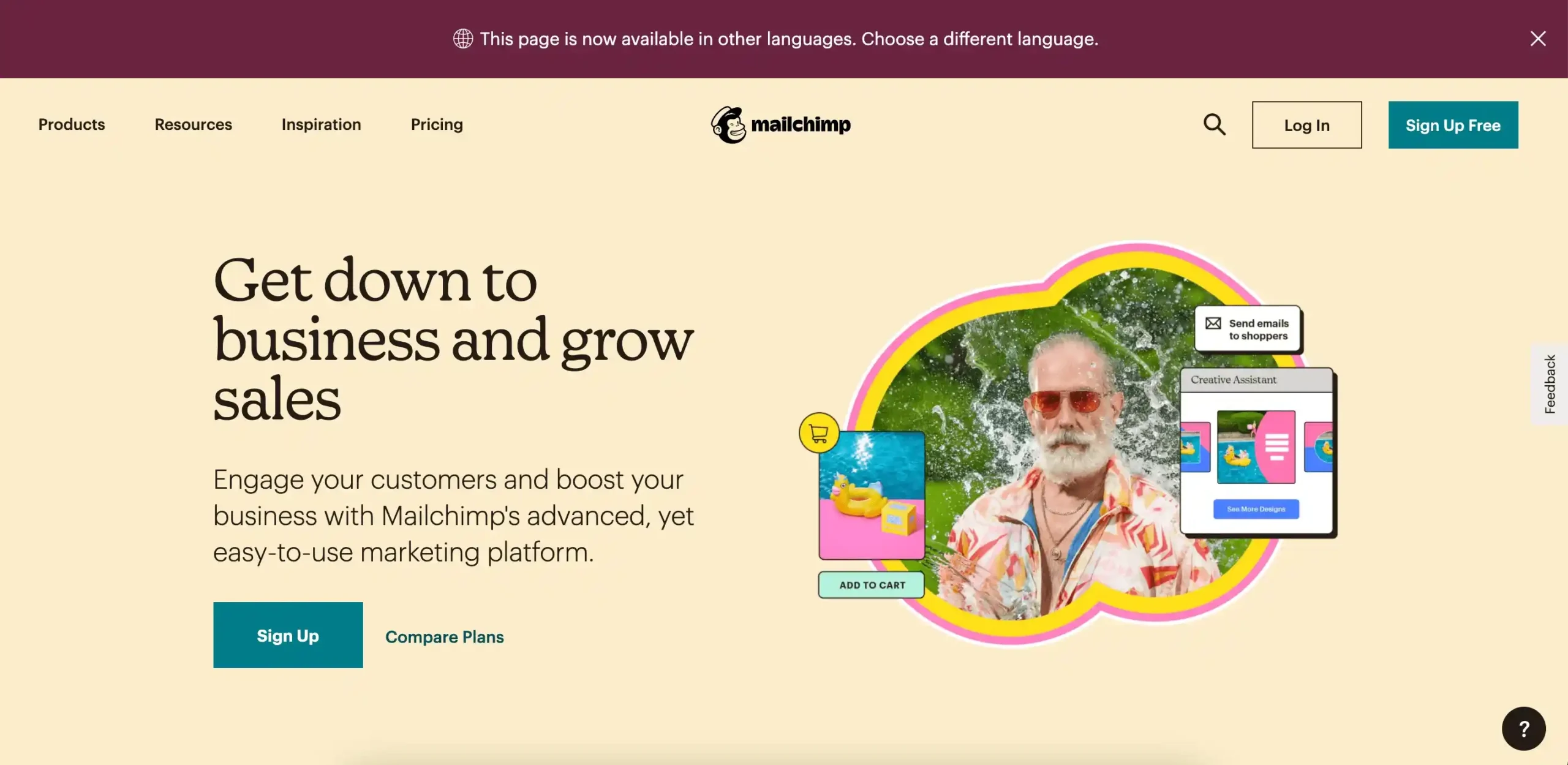
Ultimately, the company demonstrates how much it values each customer by tailoring each piece of content toward its customers’ unique challenges.
4. Client Testimonials: Venngage
Venngage took its positive client testimonials and sprinkled them throughout its website.
This social proof lets prospects know that you have a track record of reliability and have delighted previous customers beyond expectation.
Not only that, but sharing testimonials can also have a big impact on potential consumers in the consideration and decision stages.
After all, 76% of consumers “regularly” read online reviews for local businesses, which is up from 77% in 2021, so using client feedback is a great tool to attract new ones.

Image Source
5. B2B SEO: TravelPerk, Google
A B2B buyer spends 27% of the time in the purchase journey independently researching online, potentially using at least one search engine during the online research.
It’s worth the time and money to invest in making sure other businesses can find you with ease.
TravelPerk displays a diverse range of paid search and SEO. An impressive SEO strategy is its use of topic clusters and sub-topics to reach its target audience.
TravelPerk ensures that search engine pages like “business travel expenses” have a paid ad leading to its website or high-ranking blog content providing information travelers are looking for.
6. Inside Influence Marketing: IBM, Influencer and Employee Advocacy Program
IBM Systems business group has seen the growing importance of employee voice and the rise of employee influencers as a strategy in B2B marketing.
In the words of Ryan Bares, Global Social Programs Lead, he states, “In the B2B marketing world, we’ve all come to understand that buyers trust individual voices more than formal marketing and advertising messages, so finding ways to optimize influence internally is becoming a key area of focus.”
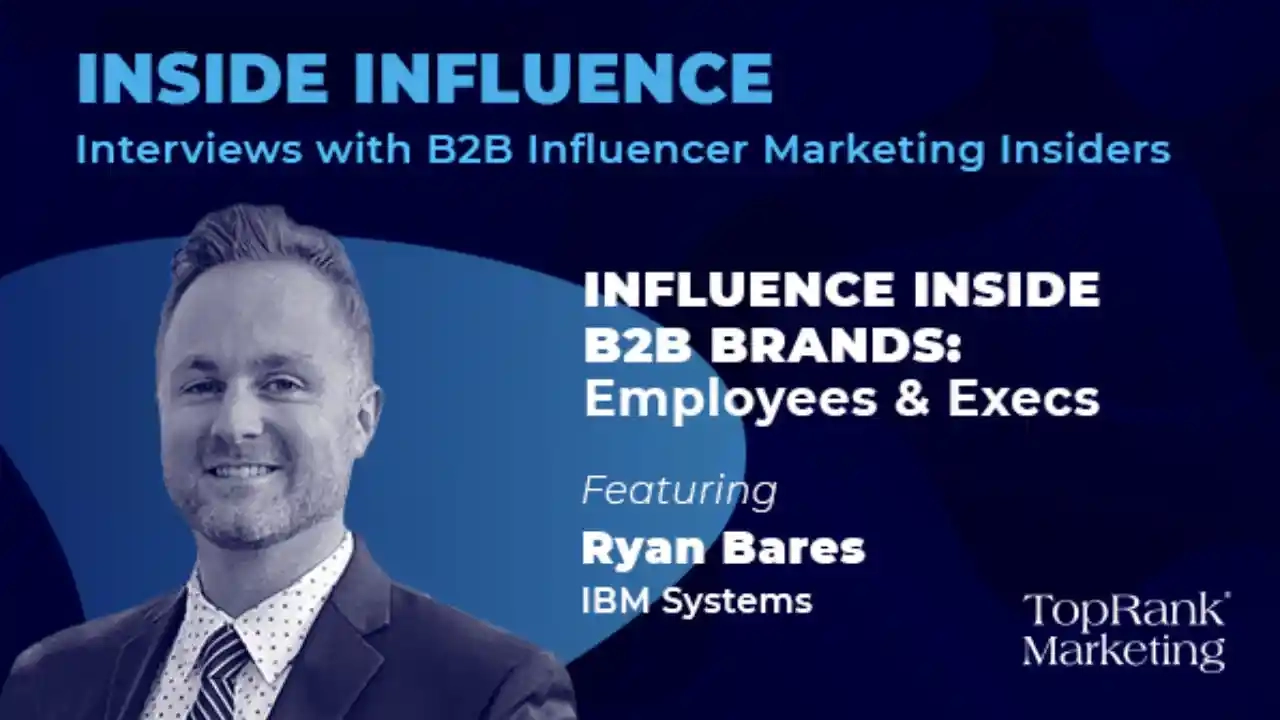
Image Source
Leveraging employees in your company who have an affinity for the industry, as well as vast knowledge of trending topics and your brand, could be key to building new relationships in the industry.
7. B2B Referral Program: Blackbaud, Blackbaud Champions
Blackbaud offers an incredible B2B referral program that incentivizes current customers to become product advocates — Blackbaud Champions.
Champions are encouraged to share their insight into how the implementation process works, what it’s like to work with the team, and how Blackbaud solutions have helped you advance their mission.
When you share your experiences, the brand will reward you with benefits.
By providing your feedback and participating in case studies you’ll earn Reward Points in the Blackbaud Champions Hub, which you can redeem from the Champions Rewards.
These points are what Champions strive to redeem, as they include incentives like discounts, complimentary passes, gift cards, VIP experiences, and more.
Image Source
Referral programs are a great way to kindle customer loyalty and have advocates spread the word about your business through the network.
Invest in B2B Marketing and Reach Your Business Customers
Marketing isn’t effective unless you keep your audience in mind, and no other audience is as fickle and critical as business customers.
Your marketing should communicate how your business can help theirs, and if it doesn’t, you can redirect your B2B marketing strategies to reach them.
Editor’s note: This post was originally published in March 2021 and has been updated for comprehensiveness.
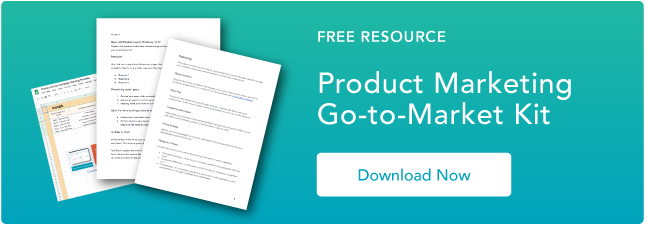
![]()
If Hubspot is of interest and you'd like more information, please do make contact or take a look in more detail here.
Credit: Original article published here.


